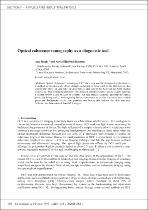JavaScript is disabled for your browser. Some features of this site may not work without it.
- ResearchSpace
- →
- Research Publications/Outputs
- →
- Conference Publications
- →
- View Item
| dc.contributor.author |
Singh, A

|
|
| dc.contributor.author |
Karsten, AE

|
|
| dc.date.accessioned | 2012-03-16T11:30:38Z | |
| dc.date.available | 2012-03-16T11:30:38Z | |
| dc.date.issued | 2011-07 | |
| dc.identifier.citation | Singh, A and Karsten, AE. Optical coherence tomography as a diagnostic tool. 56th Annual Conference of the South African Institute of Physics, St George's Hotel, Pretoria, 12-15 July 2011 | en_US |
| dc.identifier.isbn | 978-1-86888-688-3 | |
| dc.identifier.uri | http://www.saip.org.za/images/stories/documents/SAIP_Proceedings/SAIP2011_Proceedings.djvu | |
| dc.identifier.uri | http://hdl.handle.net/10204/5655 | |
| dc.description | 56th Annual Conference of the South African Institute of Physics, St George's Hotel, Pretoria, 12-15 July 2011 | en_US |
| dc.description.abstract | Optical Coherence Tomography (OCT) has been used in biomedical applications as a method to non-invasively detect changes occurring in tissue such as the detection of skin cancer. The effect of skin tone on detection of skin cancer has however not been studied extensively. Skin simulating phantoms with different optical properties can be used to optimise a system before it can be used on patients. For this reason accurately knowing the optical properties is imperative. An integrating sphere system can be used to determine these optical properties. Preliminary results from phantom and human skin indicate that skin tone may influence the data obtained from OCT images. | en_US |
| dc.language.iso | en | en_US |
| dc.publisher | South African Institute of Physics | en_US |
| dc.relation.ispartofseries | Workflow;8413 | |
| dc.subject | Optical Coherence Tomography | en_US |
| dc.subject | OCT | en_US |
| dc.subject | Skin simulating phantoms | en_US |
| dc.subject | Skin cancer | en_US |
| dc.subject | Optical properties | en_US |
| dc.title | Optical coherence tomography as a diagnostic tool | en_US |
| dc.type | Conference Presentation | en_US |
| dc.identifier.apacitation | Singh, A., & Karsten, A. (2011). Optical coherence tomography as a diagnostic tool. South African Institute of Physics. http://hdl.handle.net/10204/5655 | en_ZA |
| dc.identifier.chicagocitation | Singh, A, and AE Karsten. "Optical coherence tomography as a diagnostic tool." (2011): http://hdl.handle.net/10204/5655 | en_ZA |
| dc.identifier.vancouvercitation | Singh A, Karsten A, Optical coherence tomography as a diagnostic tool; South African Institute of Physics; 2011. http://hdl.handle.net/10204/5655 . | en_ZA |
| dc.identifier.ris | TY - Conference Presentation AU - Singh, A AU - Karsten, AE AB - Optical Coherence Tomography (OCT) has been used in biomedical applications as a method to non-invasively detect changes occurring in tissue such as the detection of skin cancer. The effect of skin tone on detection of skin cancer has however not been studied extensively. Skin simulating phantoms with different optical properties can be used to optimise a system before it can be used on patients. For this reason accurately knowing the optical properties is imperative. An integrating sphere system can be used to determine these optical properties. Preliminary results from phantom and human skin indicate that skin tone may influence the data obtained from OCT images. DA - 2011-07 DB - ResearchSpace DP - CSIR KW - Optical Coherence Tomography KW - OCT KW - Skin simulating phantoms KW - Skin cancer KW - Optical properties LK - https://researchspace.csir.co.za PY - 2011 SM - 978-1-86888-688-3 T1 - Optical coherence tomography as a diagnostic tool TI - Optical coherence tomography as a diagnostic tool UR - http://hdl.handle.net/10204/5655 ER - | en_ZA |






